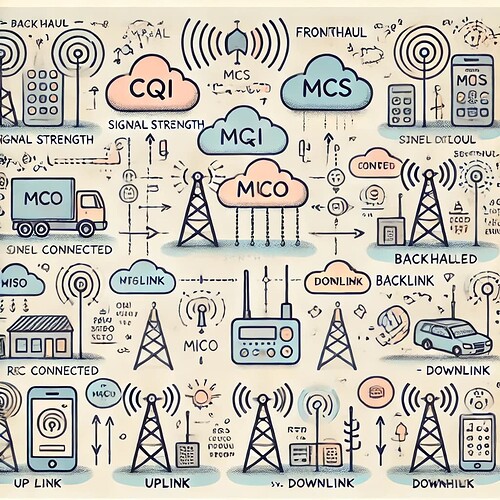In the ever-evolving world of telecom, many technical terms sound similar but have different meanings.
Mastering these distinctions is key to better network optimization and troubleshooting. Here are 15 more commonly confused terms:
![]() CQI vs. MCS – CQI (Channel Quality Indicator) reports channel conditions, while MCS (Modulation and Coding Scheme) determines data transmission parameters based on CQI.
CQI vs. MCS – CQI (Channel Quality Indicator) reports channel conditions, while MCS (Modulation and Coding Scheme) determines data transmission parameters based on CQI.
![]() SISO vs. MIMO – SISO (Single Input Single Output) uses one antenna for transmission and reception, while MIMO (Multiple Input Multiple Output) improves speed using multiple antennas.
SISO vs. MIMO – SISO (Single Input Single Output) uses one antenna for transmission and reception, while MIMO (Multiple Input Multiple Output) improves speed using multiple antennas.
![]() Backhaul vs. Fronthaul – Backhaul connects the core network to cell sites, while fronthaul connects remote radio units (RRU) to baseband units (BBU).
Backhaul vs. Fronthaul – Backhaul connects the core network to cell sites, while fronthaul connects remote radio units (RRU) to baseband units (BBU).
![]() RRC Connected vs. RRC Idle – RRC Connected means the UE is actively communicating with the network, whereas RRC Idle means the UE is registered but not transmitting data.
RRC Connected vs. RRC Idle – RRC Connected means the UE is actively communicating with the network, whereas RRC Idle means the UE is registered but not transmitting data.
![]() Uplink vs. Downlink – Uplink is data transmission from UE to the network, while downlink is from the network to UE.
Uplink vs. Downlink – Uplink is data transmission from UE to the network, while downlink is from the network to UE.
![]() GNB vs. ENB – gNB (Next-gen NodeB) is used in 5G networks, while eNB (Evolved NodeB) is used in LTE networks.
GNB vs. ENB – gNB (Next-gen NodeB) is used in 5G networks, while eNB (Evolved NodeB) is used in LTE networks.
![]() HARQ vs. ACK/NACK – HARQ retransmits corrupted packets with error correction, while ACK/NACK are signals indicating successful or failed packet reception.
HARQ vs. ACK/NACK – HARQ retransmits corrupted packets with error correction, while ACK/NACK are signals indicating successful or failed packet reception.
![]() SIB vs. MIB – MIB (Master Information Block) provides basic system info, while SIB (System Information Block) carries additional configuration details.
SIB vs. MIB – MIB (Master Information Block) provides basic system info, while SIB (System Information Block) carries additional configuration details.
![]() TAC vs. PCI – TAC (Tracking Area Code) identifies a group of cells, while PCI (Physical Cell ID) uniquely identifies a specific cell.
TAC vs. PCI – TAC (Tracking Area Code) identifies a group of cells, while PCI (Physical Cell ID) uniquely identifies a specific cell.
![]() Carrier Aggregation vs. Dual Connectivity – Carrier Aggregation combines multiple frequency bands for higher throughput, while Dual Connectivity connects to two different base stations.
Carrier Aggregation vs. Dual Connectivity – Carrier Aggregation combines multiple frequency bands for higher throughput, while Dual Connectivity connects to two different base stations.
![]() Interference vs. Noise – Interference is unwanted signals from other sources, while noise is random background signals affecting communication.
Interference vs. Noise – Interference is unwanted signals from other sources, while noise is random background signals affecting communication.
![]() Paging vs. Registration – Paging is how the network finds an idle UE for an incoming call/data, while registration is when UE updates its location with the network.
Paging vs. Registration – Paging is how the network finds an idle UE for an incoming call/data, while registration is when UE updates its location with the network.
![]() RTP vs. RTCP – RTP (Real-Time Transport Protocol) delivers audio/video, while RTCP (Real-Time Transport Control Protocol) monitors quality.
RTP vs. RTCP – RTP (Real-Time Transport Protocol) delivers audio/video, while RTCP (Real-Time Transport Control Protocol) monitors quality.
![]() EIR vs. HLR – EIR (Equipment Identity Register) tracks stolen devices, while HLR (Home Location Register) stores subscriber details.
EIR vs. HLR – EIR (Equipment Identity Register) tracks stolen devices, while HLR (Home Location Register) stores subscriber details.
![]() C-RAN vs. D-RAN – C-RAN (Centralized RAN) processes multiple sites at a central location, while D-RAN (Distributed RAN) has each site operating independently.
C-RAN vs. D-RAN – C-RAN (Centralized RAN) processes multiple sites at a central location, while D-RAN (Distributed RAN) has each site operating independently.
LinkedIn: ![]()
![]() You may also like this: Telecom Terms That Often Cause Confusion - Part 1
You may also like this: Telecom Terms That Often Cause Confusion - Part 1
